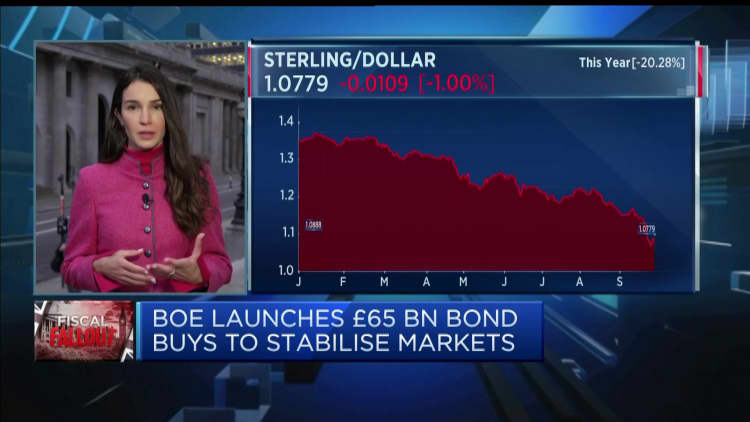Buses pass in the City of London financial district outside the Royal Exchange near the Bank of England on 2nd July 2021 in London, United Kingdom.
Mike Kemp | In Pictures | Getty Images
LONDON — The Bank of England told lawmakers that a number of pension funds were hours from collapse when it decided to intervene in the U.K. long-dated bond market last week.
The central bank’s Financial Policy Committee stepped in after a massive sell-off of U.K. government bonds — known as “gilts” — following the new government’s fiscal policy announcements on Sept. 23.
The emergency measures included a two-week purchase program for long-dated bonds and the delay of the bank’s planned gilt sales, part of its unwinding of Covid pandemic-era stimulus.
The plunge in bond values caused panic in particular for Britain’s £1.5 trillion ($1.69 trillion) in so-called liability-driven investment funds (LDIs). Long-dated gilts account for around two-thirds of LDI holdings.
Many LDIs are owned by final salary pension plans, workplace pensions popular in the U.K. that provide a guaranteed annual income for life upon retirement, based on the worker’s final or average salary.
The LDIs needed to liquidate substantial portions of their long-term gilt positions as the values of the bonds fell early last week, and could have done so in an orderly fashion providing gilt prices did not deteriorate too rapidly.
In a letter Wednesday to Conservative Party lawmaker Mel Stride, chairman of the Treasury Select Committee, Bank of England Deputy Governor Jon Cunliffe revealed that LDIs issued dire warnings on the evening of Sept. 27, as 30-year gilt yields rose by 67 basis points from their position that morning. Yields move inversely to prices.
“The Bank was informed by a number of LDI fund managers that, at the prevailing yields, multiple LDI funds were likely to fall into negative net asset value. As a result, it was likely that these funds would have to begin the process of winding up the following morning,” Cunliffe said.
“In that eventuality, a large quantity of gilts, held as collateral by banks that had lent to these LDI funds, was likely to be sold on the market, driving a potentially self-reinforcing spiral and threatening severe disruption of core funding markets and consequent widespread financial instability.”

Bank of England staff worked through the night on Tuesday, Sept. 27 to come up with an intervention that would avert this potential crisis, in “close communication” with the U.K. Treasury, which agreed the next morning to indemnify the bank’s rescue operation.
The 30-year gilt yield fell more than 100 basis points after the bank announced its emergency package on Wednesday Sept. 28, offering markets a much-needed reprieve.
Cunliffe noted that the scale of the moves in gilt yields during this period was “unprecedented,” with two daily increases of more than 35 basis points in 30-year yields.
“Measured over a four day period, the increase in 30 year gilt yields was more than twice as large as the largest move since 2000, which occurred during the ‘dash for cash’ in 2020,” he said.
“It was more than three times larger than any other historical move. Gilt market functioning was severely stretched, particularly at the long end of the curve.”
Image and article originally from www.cnbc.com. Read the original article here.

